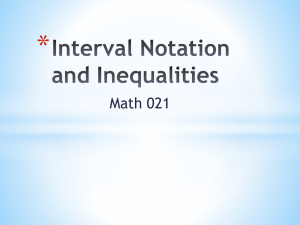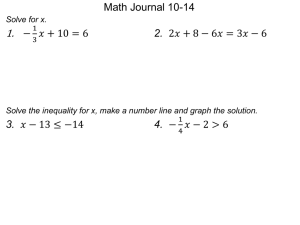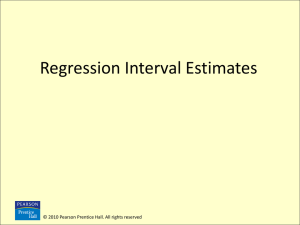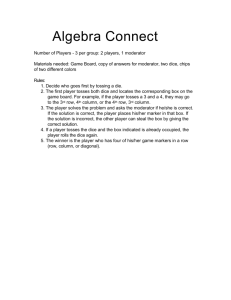Inequalities
advertisement
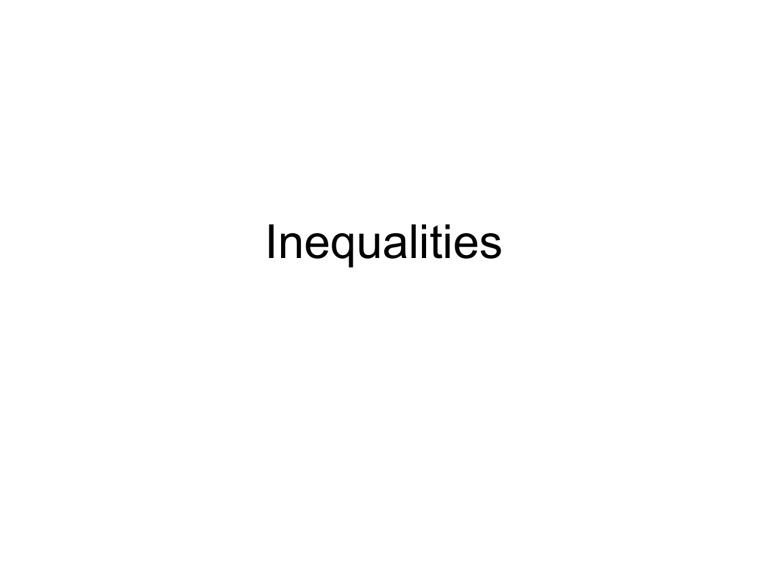
Inequalities Objectives • Understand the laws for working with inequality symbols • Solve linear inequalities • Solve quadratic inequalities Linear inequalities 3 x 10 10 x 11 3 x 10 x 11 10 7 x 21 x3 • You can add or subtract a number on both sides of an inequality • You can multiply or divide an inequality by a positive number • You can multiply or divide an inequality by a negative number, but you must change the direction of the inequality Quadratic Inequalities ax 2 bx c a( x p)( x q) a( x r ) 2 s usual form factor form completed square form Easier form to use with inequalities An interval (AND) example: Method 1 y is less than 0 Coefficients of x2 is positive the parabola bents upwards y x 2x 4 0 Intersects the x axis at 2 and 4 Please note that 2 is less than 4 Be careful, this does not make sense; x can’t be both (AND) greater than 7 and less than 3. Ok for OR condition 7< x <3 Please note that 7 is not less than 3 X must be both greater than 2 AND less than 4 2<x<4 interval Method 2 (tabular method) y x 2x 4 0 x<2 x=2 2<x<4 x=4 x>4 x-2 - 0 + + + x-4 - - - 0 + (x-2)(x-4) + 0 - 0 + x 2x 4 0 X > 2 AND X < 4 For what values of input the output will be less than 0? x f x 3x 2 3x 18 3x 6x 3 x<-2 x=-2 -2<x<3 x+2 - 0 + x-3 - (x+2)(x-3) + 0 x=3 y The graph is below x axis for input values between -2 and 3. in other words the output of the function is negative for input values between -2 and 3 x>3 + - 0 + - 0 + Range (interval) bound The graph shows the output (y) of the function for various inputs (x) x 2x 3 0 X > -2 AND X < 3 Range (interval) bound OR instead of AND Either condition would satisfy For what values of input the output will be greater than 0? x f x 3x 2 3x 18 3x 6x 3 X < -2 X>3 The graph is above x axis if input values are < -2 or > 3. in other words the output of the function is positive for input values < -2 and > 3 y Not range (interval) bound x<-2 x=-2 -2<x<3 x+2 - 0 + x-3 - (x+2)(x-3) + 0 x=3 x>3 + - 0 + - 0 + x 2x 3 0 X < -2 OR X > 3 Not range (interval) bound The graph shows the output (y) of the function for various inputs (x) If two products are positive, then either they both should be positive or they both should be negative ( x 3)(3x 6) 0 Scenario 1 Scenario 2 If two products are negative, then one should be negative and the other should be positive ( x 3)(3x 6) 0 Scenario 1 Scenario 2 (3x 6) 0 x 2 (3x 6) 0 x 2 (3x 6) 0 x 2 (3x 6) 0 x 2 ( x 3) 0 x 3 ( x 3) 0 x 3 ( x 3) 0 x 3 ( x 3) 0 x 3 This means x > 3 This means x < -2 This is a OR condition (not range/interval bound) This means -2< x > 3 This means x < -2 x must be both greater than 3 and less than -2. This AND condition is impossible. Another Example: OR criteria (not range/interval bound) Coefficients of x2 is negative the parabola bents downwards (vertex at the top) Y>0 Y<0 ( x 1)(5 x) 0 Intersects the x axis at -1 and 5 x 1 Critical values Either condition would satisfy OR instead of AND x5 x2 a2 a0 x 2 a 2 ( x a)( x a) 0 It is easier to assign simple values to a Critical values are x= –a and x =+a Ex: x = -4 Ex: x = 2 Ex: x = 4 x<-3 x=-3 -3<x<3 x=3 x>3 x-3 - - - 0 + x+3 - 0 + + + (x-3)(x+3) + 0 - 0 + a x a x2 a2 Both are equivalent Another Approach If two products are negative, one of them MUST be negative and the other MUST be positive (2 x 1)( x 3) 0 Scenario 1 Scenario 2 (2 x 1) 0 x 1 2 (2 x 1) 0 x 1 2 ( x 3) 0 x 3 ( x 3) 0 x 3 x must be both greater than 3 and less than -1/2. This AND condition is impossible. x must be both less than 3 and greater than -1/2. If two products are positive, then either they both should be positive or they both should be negative (2 x 1)( x 3) 0 Scenario 1 (2 x 1) 0 x 1 ( x 3) 0 x 3 This means x > 3 2 Scenario 2 (2 x 1) 0 x 1 2 ( x 3) 0 x 3 This means x < -1/2 This is a OR condition (not range/interval bound) Don’t have a calculator and can’t factorize the equation or your mean teacher asked you to solve algebraically: complete the square Square means a positive value 2 x 2 8x 11 0 2( x 2) 2 3 0 There is no value of x for which this condition is possible Equals 0 when x = 2 ; the smallest value 2 x 2 8 x 5 2( x 2) 2 3 0 x 2 2 We saw this a couple a slides ago. 3 3 x2 2 2 2 3 2 3 3 x 2 2 2 x 2 a 2 a x a We have two functions: y1, y2. Find the range of x values (domain) so that y1 > y2 y2 x 4 3x y1 1 2 1 3x x4 x 2 2 y2 y1 Graphical proof: the graphs seem to intersect at (2, -2). When x is smaller than 2, y1 is greater than y2 x 5 2 x 5 4 2 Scenario 1 x 2 10 x 21 0 x 7 0 x 3 0 x 2 7 x 3 x 21 0 Scenario 2 x 2 10 x 25 4 0 x x 7 3 x 7 0 x 7 x 3 0 x 7 0 x 3 0 3 x 7 x5 2 x 5 2 x 5 2 or x 5 2 This is impossible 3 x 7 x7 x 5 2 x3


